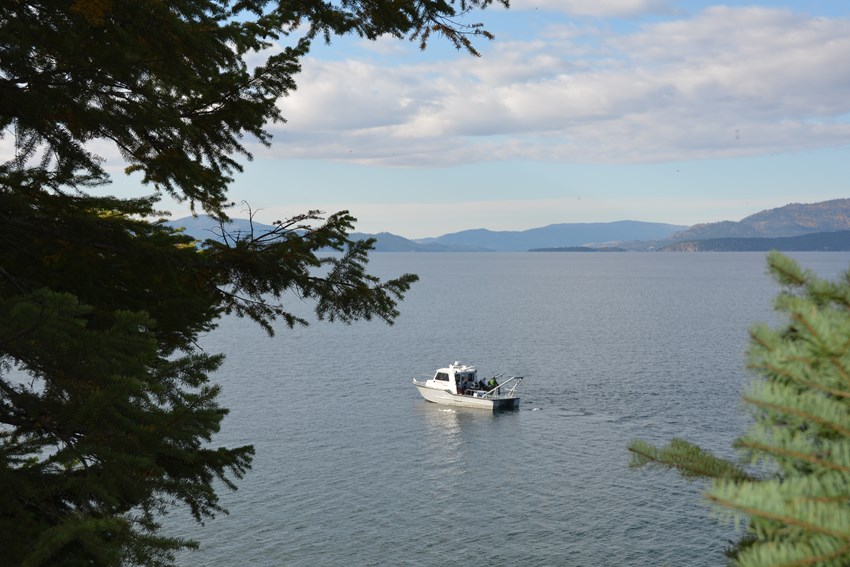Deep Dive into FLBS: The Appreciation of Gratitude
Written from the perspective of FLBS Media and Information Specialist Ian Withrow, each "Deep Dive into FLBS" column features entirely original content and provides a behind-the-scenes glimpse at Bio Station science, researchers, partners and programs. Stay tuned for future installments in upcoming editions of the Bigfork Eagle.
Growing up, my relationship with gratitude was relatively superficial. I suspect I’m not alone in this. My earliest childhood memories of giving thanks were pop quizzes, when I was incessantly tested with adult-proctored questions like, “Now, what do we say?” I failed often, because (in my defense) there are technically two correct answers to this question, and only one of them—the magical “Please”—meant a chance for more candy, cartoons, or toys. For me, “Thank You” was a conclusion. It implied the end of the opportunity for more.
It wasn’t long before appreciation became a polite reflex for me, an automated response whenever someone handed me something or said something nice. As I approached my teenage years, my thank yous condensed into less thoughtful but notably edgier terms, like “Cool” or the more cringe worthy “Sweet.” These terms, otherwise known as the “I wear my hat backwards but still live with my parents” versions of mandatory appreciation, unfortunately continue to hold a spot in personal lexicon to this day.
By the time I reached high school, I discovered the ease with which adults were able to sandwich gratitude between more potent sentiments like guilt and good fortune (“You should be thankful.” Or “You don’t know how lucky you are…”). Later, during my college years, I fell into the habit of cynically rejecting appreciation in the name of societal rebellion (“I don’t need to appreciate everything all of the time. I’m not a stock investment.”).
To be clear, it wasn’t that I was intentionally insincere with my gratitude. But within the evolution of my appreciative outlook, there existed a single uncomfortable truth: It was rarely something that I truly felt deeply. Not in my core, anyway. Not where it matters. Not, at least, until now.
As I write this, Bio Station Aquatic Invasive Species (AIS) specialist Phil Matson is in his office down the hall, diligently putting the final touches on his 2021 FLBS invasive mussel monitoring report. This was another massive year for AIS prevention in Montana. Out-of-state visitation remains on the rise, and new residents are moving into the Flathead Watershed every day. This continued “discovery” of Montana has dramatically increased the risk of invasive mussel infestations. This year, 61 mussel-infested watercraft were intercepted at state and tribal boat inspection stations. For those keeping score at home, the previous record, set in 2020, was only 35.
Behind those front lines of prevention at Montana’s boat inspection stations, Matson and his AIS monitoring team were busy assisting a rigorous and collaborative statewide early detection survey of our waters. This monitoring is to ensure that, if a mussel-infested boat somehow makes it into our waters without getting cleaned, drained, and dried, the invading mussels (or other AIS) are detected as early as possible. Funded by grants from Montana Department of Natural Resources and Conservation, Matson’s team completed three rounds of sampling on Flathead Lake and two rounds of sampling on Tiber Reservoir.
Matson doesn’t work alone, of course. He continues to collaborate closely with the Confederated Salish and Kootenai Tribes (CSKT) and Montana Fish, Wildlife & Parks (FWP), and also benefits from an incredible team of volunteers. This year, those volunteers included seven Big Sky Watershed Corps Members, four FLBS interns, and students from the University of Montana and Salish Kootenai College. In addition to overseeing the FLBS AIS monitoring program, Matson also participated in important outreach efforts, like the Mussel Walk for local middle school students, co-hosted alongside CSKT educators, the Flathead Lakers, and Montana State Parks.
The importance of this expansive early detection monitoring and educational outreach can’t be overstated. The Flathead Watershed is within the headwaters of the Columbia River, still the only major river system in the continental US without invasive mussels. Meanwhile, Tiber Reservoir, in the headwaters of the Missouri River, was listed as “positive” for invasive mussels in 2016. Since then, Tiber has gone five years without another positive detection, and barring another positive sample, is on the brink of being delisted.
The Flathead Lake and Tiber AIS samples went to various labs for analysis. Matson has the results, and I can hear him walking toward my office now.
As a kid, my appreciation was the polite punctuation to a transaction. As an adult—or more specifically, as a parent—I am most deeply grateful for every chance that I’m given to fully appreciate all that I love and haven’t lost. It’s what I feel for the healthcare providers who continue to pull us through this pandemic, and the doctors who kept my daughter alive during the first year of her life, when she required the constant use of oxygen to remind herself to breathe. It’s what I feel when I see a random act of kindness, or when my wife forgives me for eating the entire pan of cookies that were meant for her high school students, instead of making me sleep in the garage.
It’s what I feel when Phil Matson steps into my office to report that once again, the labs have found no invasive mussels in any of the samples taken this year, and none of the samples tested positive for the presence of invasive mussel DNA.
In this moment, I am so very grateful to everyone working tirelessly today to provide me with the opportunity of being thankful for all that I love tomorrow. A safe and pleasant holidays, from all of us at FLBS.


